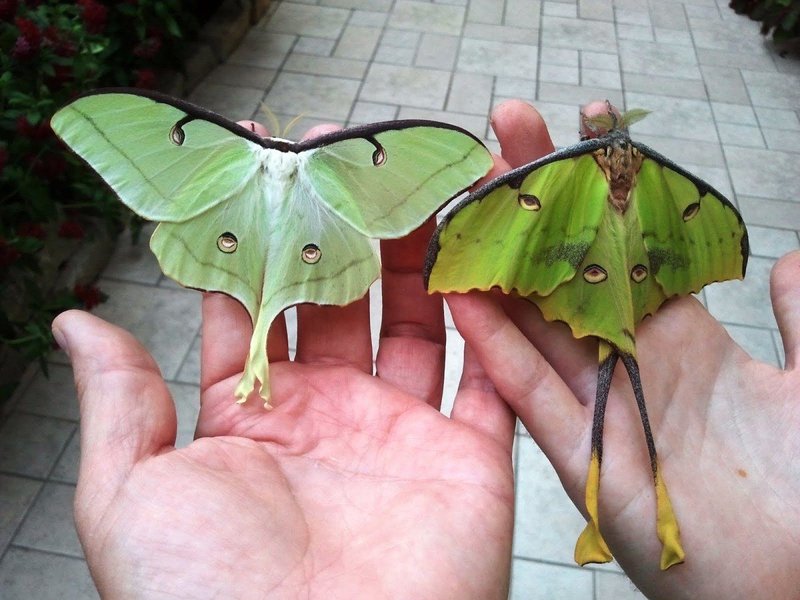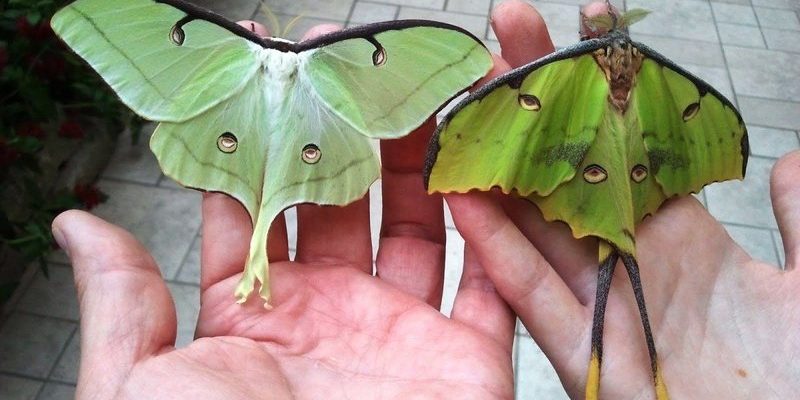
In this article, we’ll take a closer look at the Luna Moth and some of its similar counterparts in the insect world. We’ll explore their characteristics, behaviors, and habitats, helping you understand what makes the Luna Moth special and how it compares to its insect friends. Whether you’re a budding entomologist or just someone who appreciates nature, this journey into the world of moths will be both fascinating and enlightening.
What is a Luna Moth?
The Luna Moth (Actias luna) is one of North America’s largest and most visually striking moths. With a wingspan that can reach up to 4.5 inches, its vibrant lime-green wings are adorned with eye spots that resemble large, watchful eyes. These spots serve a dual purpose: they can deter predators by creating an illusion of a larger creature and help the moth camouflage among leaves.
Luna Moths are nocturnal and primarily active at night. They are particularly attracted to light, which is why you might find them around porch lights or streetlamps. They don’t eat in their adult stage; their primary goal is to reproduce. How wild is that? All those beautiful wings and no dinner plans! They emerge from cocoons in late spring and only live for about a week—just long enough to find a mate.
Life Cycle of the Luna Moth
To truly appreciate the Luna Moth, it’s essential to understand its life cycle. Like many moths, the Luna Moth undergoes complete metamorphosis, which includes four stages: egg, larva (caterpillar), pupa (cocoon), and adult moth.
– Egg: The female lays around 200 eggs on the underside of leaves, primarily of trees like walnut and hickory.
– Caterpillar: Once hatched, the larvae are known for their striking appearance—green and spiky, making them look like little creatures from a fantasy world. They munch on leaves voraciously, growing rapidly.
– Pupa: After about a month, the caterpillar transforms into a cocoon, where it enters a dormant state.
– Adult: Finally, it emerges as a stunning Luna Moth, ready to continue the cycle.
This fascinating transformation highlights the beauty of nature’s design, showcasing how life can start so small and evolve into something so breathtaking.
Similar Moths: The Giant Silk Moth
If you’re captivated by the Luna Moth, you might also be interested in the Giant Silk Moth. This family includes several species, such as the Polyphemus Moth and the Cecropia Moth, which share similarities in size and appearance but have their unique traits.
The Polyphemus Moth is known for its distinct eye spots and rich brown and tan patterns, making it a bit less vibrant than the Luna Moth but still striking in its own right. The Cecropia Moth is the largest native moth in North America, boasting a wingspan of up to 6 inches! These moths, like the Luna, do not feed as adults, focusing their energy on mating.
Habitat and Behavior
Both the Giant Silk Moth and Luna Moth thrive in similar habitats. They are commonly found in forests, gardens, and areas with abundant foliage. Interestingly, while the Luna Moth prefers hardwood trees, the Giant Silk Moth often lays its eggs on fruit trees and shrubs.
Their nocturnal habits mean that they’re not often seen during the day, which adds to their allure. It’s like they’re quietly living their lives in the shadows, only revealing their beauty when the moon is high.
The Death’s-Head Hawkmoth: A Unique Comparison
Now, let’s switch gears a bit and talk about the Death’s-Head Hawkmoth. With its eerie name and skull-shaped markings on its back, you might think it’s all doom and gloom. But don’t be fooled! This moth is just as fascinating as the Luna Moth, albeit in a different way.
Unlike the Luna Moth, the Death’s-Head Hawkmoth can be found active during the day. They have a more robust build and are known for their ability to produce a loud squeaking sound, which can startle potential predators. With a wingspan of up to 5.5 inches, it’s comparable to the Luna Moth in size, yet its darker coloration gives it a vastly different appearance.
Feeding Habits
One major difference lies in their feeding habits. The Death’s-Head Hawkmoth is notorious for raiding honeybee hives for food, making it a bit more aggressive than the gentle Luna Moth. In contrast, the Luna Moth, with its non-feeding adult stage, focuses entirely on reproduction without the need for sustenance.
This stark difference can be a great point of discussion among insect enthusiasts. It begs the question: what adaptations help these moths thrive in their respective environments?
How the Luna Moth Fits Into the Ecosystem
Understanding the role of the Luna Moth in its ecosystem is vital. As a pollinator, the Luna Moth plays an essential part in the lifecycle of various plants. While they don’t feed on nectar as adults, their larvae help in leaf consumption, contributing to the natural process of decay and recycling nutrients back into the soil.
The Luna Moth, with its unique beauty, also serves as an indicator of environmental health. If they’re thriving, it’s a good sign that the ecosystem is balanced and functioning well. Sadly, like many insects, they face threats from habitat destruction and pesticides, making awareness critical.
Conservation Efforts
Conservation efforts are underway in many regions to protect habitats where the Luna Moth lives. Planting native trees and reducing pesticide use are simple steps anyone can take to support these gentle giants and their peers.
By prioritizing a healthy environment for moths, we’re also creating a better habitat for many other creatures. It’s all interconnected—what benefits the Luna Moth can help countless species thrive.
Final Thoughts on Luna Moth vs. Similar Insects
So, when you compare the Luna Moth to similar insects, the differences can be striking. From their life cycles and feeding habits to their ecological roles, each species has unique features that contribute to the wonderful tapestry of life around us. Whether it’s the soft colors of the Luna Moth or the more dramatic patterns of the Giant Silk Moth and Death’s-Head Hawkmoth, there’s a story that connects each of them.
The Luna Moth invites us to appreciate nature’s beauty and the intricate relationships that exist within ecosystems. The more we learn, the more we can take steps to protect these incredible creatures and their habitats—one moth at a time. So next time you see a Luna Moth fluttering by, take a moment to appreciate the delicate dance of life happening all around you.

